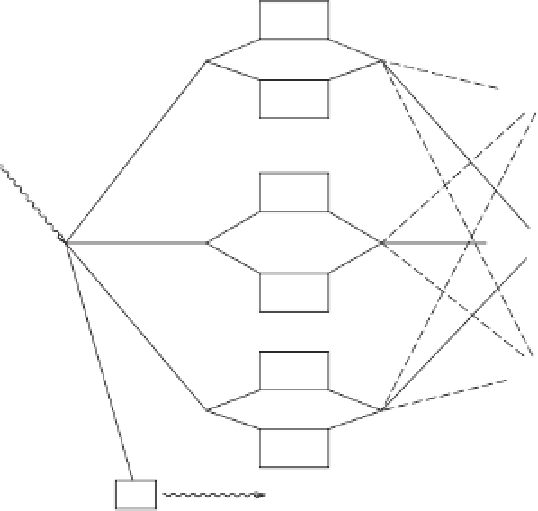Environmental Engineering Reference
In-Depth Information
839 consecutive hours. Any such simulation may be
compared to the corresponding 839 hours of field data
collected at the subcatchment between August and
September 1993. The field data also include hourly
rainfall which is used as a forcing function (RAIN) to
the model. There is a second forcing function, actual
evapotranspiration (AET), which is modelled as a
deterministic sinusoidal function of time.
sodium, and
z
represents the corresponding field data.
The function
f
(
) relating
y
to
x
is developed as follows.
There is a fast
f
and a slow
s
sub-compartment for
each of the three soil-type compartments DP, AS and
GW. Updating the effective water stored from hour t to
hour
t
·
1 for each sub-compartment is governed by the
equations:
+
ES
soil
(
t
ES
soil
(
t
)
r
soil
(
t
)
p
soil
RAIN(
t
)
+
1)
=
+
26.3.1 Mathematicalmodel
c
f
soil
ES
f
soil
(
t
)
ES
soil
(
t
+
1)
=
ES
soil
(
t
)
+
r
soil
(
t
)
p
soil
RAIN(
t
)
−
−
The model, depicted in Figure 26.1, comprises three com-
partments with parallel transfer, whereby water, input as
rain, may enter three compartments representing three
different soil types, 'Direct Precipitation' (DP), 'Acid Soil'
(AS) and 'Ground Water' (GW). The water is stored in
each compartment for a fast or slow amount of time
before being discharged into the streams. The water can
instead enter the 'Ineffective Storage' compartment, in
which case it will not be discharged and can only leave the
system via actual evapotranspiration (AET). Six parame-
ters
a
soil
,
b
soil
,
k
soil
,
p
soil
,
c
soil
and
c
soil
characterize the fluid
dynamics of water flow through each soil (DP, AS, GW),
subject to the constraint
k
DP
+
c
soil
ES
soil
(
t
)
where
soil
is one of DP, AS and GW,
p
soil
+
p
soil
=
1,
k
soil
r
soil
(
t
)
=
b
soil
S
(
t
)]
with
k
DP
+
k
AS
+
k
GW
=
1and
S
(
t
), the total water stored
in the system at time
t
is given by:
1
+
exp[
a
soil
−
[
ES
soil
(
t
)
ES
soil
(
t
)]
S
(
t
)
=
+
+
IS
(
t
)
soil
1, leaving
17 functionally independent input parameters. Details
of parameter descriptions, ranges and units are given in
Iorgulescu
et al
. (2005).
Thus, in terms of the general description given in
Section 26.2, the input vector
x
has 17 components,
y
represents the three time series for discharge, calcium and
k
AS
+
k
GW
=
That is, the
total water storage S
in the system at any
timeisthesumofthe
effective storages
for each soil type,
both fast and slow, plus the overall residual
ineffective
storage IS
. Physical interpretations of the six parameters
for each compartment will emerge in the next subsection.
Updating the total storage from time
t
to time
t
+
1is
ES
f
DP
p
f
DP
c
f
DP
p
DP
c
DP
ES
DP
Calcium
r
DP
RAIN
ES
f
AS
p
f
AS
c
f
AS
r
AS
Discharge
p
AS
c
AS
ES
AS
r
GW
∑
1 -
r
soil
p
f
GW
ES
f
GW
c
f
GW
Silicon
soil
p
s
GW
c
s
GW
ES
s
GW
Figure 26.1
Three compartment rainfall-runoff
model.
IS
AET



Search WWH ::

Custom Search